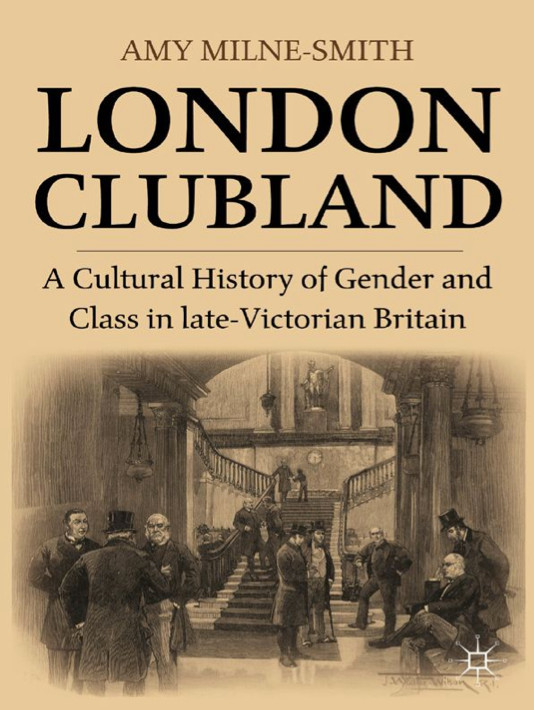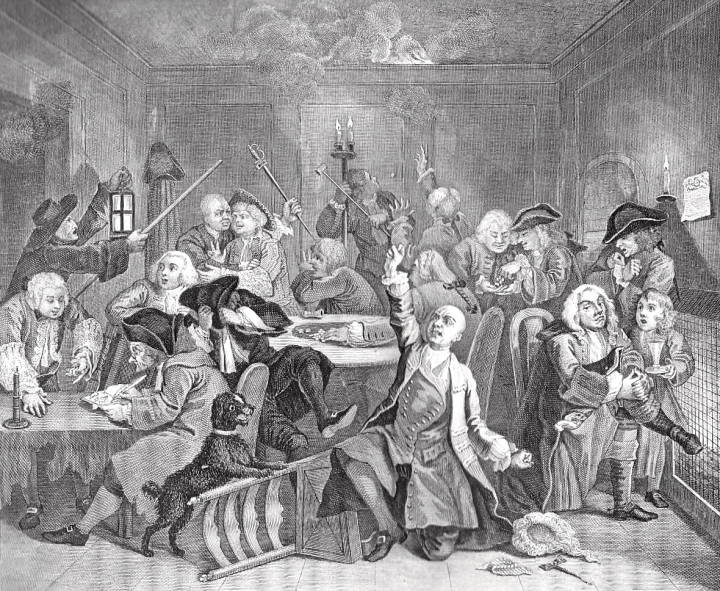Formatted with illustrations, captions and links by Jacqueline Banerjee. All illustrations except the first one, showing the cover of the book under review, are from elsewhere on our own website. Please click on the images for larger pictures and more information, including details of their sources.

Most, if not all, of London's long-established clubs have their own histories, usually written to celebrate an anniversary. They range from the pedestrian and factual to the entertaining and anecdotal but inevitably rest on an unquestioning assumption of the significance and value of the institution they describe, an assumption that would be shared by the author and the intended readership in each case. Each was written for members who needed no convincing of the importance of the club to which they belonged.
Despite this self-importance, nineteenth-century clubs have been waiting a long time for objective analysis of the phenomenon of clubs as a whole. Now, like London buses, after a long wait, two come at once. London Clubland was published in 2011 and was quickly followed by Barbara Black's A Room of His Own already reviewed on this website. It is sometimes discouraging to open a book and discover that it began life as PhD dissertation, but Amy Milne-Smith has produced a book whose origins would not be detectable if she didn't tell us in the acknowledgments.


"From coffee-houses and gambling...." Left: William Hogarth's Gambling House Scene, Plate VI from The Rake's Progress, said to have been based on White's. Right: St. James's Street. Showing White's and the Devonshire Clubs by W. Hatherell. c.1890.
Chapter One sketches the history of clubs from coffee houses and gambling to the high point of their prominence in the last 15 or 20 years of the nineteenth century. With an occasional licence to roam, the book concentrates on that late Victorian period. It illustrates the vulnerability of clubs even when their general popularity had reached its peak. White's, for example, probably the oldest club, had only 200 paying members in 1888 when it typically had had 750 and there were no candidates awaiting consideration. If it had not quickly turned the corner under new management it would not have survived to remain one of the most prominent London clubs in the twenty-first century.
The business of electing new members and rejecting them by use of black balls is covered in Chapter Two. Milne-Smith successfully communicates how entertaining elections could be. Some members were rejected on personal grounds understandable in the society of the 1880s and 1890s. Some were rejected because of their political stance on a controversial issue. For example, the Reform and Brooks's were both bedevilled by unionists ensuring the rejection of home rulers and vice versa. There were few to be found in Liberal and Whiggish circles who had no view on the future of Ireland. The chapter unearths examples of candidates being rejected on the sole ground that they were not already members, one illustration of several in the book that clubs have always embraced a range of eccentrics. It also brings out the risks of blackballing when it had the effect of allowing through the mediocre and rejecting the distinguished on grounds of jealousy as well as the notorious. A recurring and unexpected solecism occurs for the first time in Chapter Two when the Prince of Wales is referred to as Prince Edward. He only announced his wish to use Edward after he succeeded his mother. Before that he was always Albert Edward outside the family though, of course, more commonly known as the Prince of Wales.
From time to time clubs needed to deal with a member who perhaps ought to have been blackballed but had been elected. The regulation of the behaviour of members, the examination of bad behaviour and the occasional resignation or expulsion of members are discussed in Chapter Three. It is a rich field for splendid anecdotes about bad cheques, fighting, drinking, swearing and gambling. Rudeness to staff was a serious matter in the nineteenth century as it still is in clubs today. It would have been interesting to read more about the use of apparently voluntary resignation as a way for avoiding the problems of formal expulsion, but it is perhaps part of the point of such behind the scenes pressure that it is less likely to leave anything for the historian to discover.
Disputes about the power of committees and general meetings to expel could reach the courts. A case brought by a Colonel Dawkins against the Travellers was heard by the Master of the Rolls and then on appeal but the club's decision to expel was upheld. One is left to wonder how pleasant it would have been for the Colonel if the courts had restored his membership. Clubs generally supported their committees, perhaps because they were carefully chosen to represent majority opinion, perhaps out of gratitude for shouldering a tedious responsibility on behalf of the membership generally.
Talk generally, and gossip in particular, is covered in Chapter Four. One main point is summarised thus: "Clubmen needed and used the power of exclusionary gossip to monitor behaviour and, more importantly, to reinforce their sense of "insider" status." The other point is that, though there were limits to the reticence, members could mostly rely on what was heard in a club staying in the club. The long breach in the relationship between Dickens and Thackeray arose because Thackeray held that a friend of Dickens had made use of information picked up in the Garrick in a published column about Thackeray. It may, of course, have been seen as more acceptable if the column had been entirely complimentary.



"It was rare that even the grandest London home would have been able to compete." Left to right: (a) The Grand Staircase, the Athenaeum. (b) Interior of saloon: the former Conservative Club. (c) View from the Library: the Garrick Club.
Talk and gossip fail to provide such rich material as other topics but Chapter Five on the club as home has plenty of excellent material although the suggestion that their very success in aping the comforts of home may have threatened marriage and marriages is probably overdone for all but a small minority. Milne-Smith's summary of what they offered is undeniably true of at least some clubs: "A member found a first-class library, dining spaces to rival the top restaurants, some of the best card and billiard players, the finest cellars in the country, and a place to meet his friends — all in his club. It was rare that even the grandest London home would have been able to compete."
The interest of members and their privacy were safeguarded by club servants who got to know members and the club's traditions over decades. Peace and quiet were valued as much as company by many club members, and Milne-Smith is no doubt right to suggest that they were easier to find in a club than in the home. The chapter includes an excellent account of the discomfort of having to use another, less familiar club when one's own club was closed for refurbishment or cleaning and explores the joy of returning specifically to one's club after years of working overseas. Nonetheless one suspects that for most members in the late Victorian period as at other times, the club formed part of a balanced life and that home life did not suffer. Bachelors and the unhappily married did not make up the majority of the users of London clubs.

"Peace and quiet were valued as much as company": The Morning Room, the Athenaeum.
This theme continues into Chapter Six which considers whether by making life as a bachelor so pleasant it was subverting the institution of marriage and, alternatively, whether it made bad husbands when bachelors changed their status. Milne-Smith concludes that heterosexual bachelors were not held back from marriage but that there was a period in the heyday of clubs when wives were neglected. While accepting that many clubs are now equally open to men and women and that they were increasingly accessible for years before membership became possible, she argues that women did not need to gain access to clubs to see more of their husbands because husbands began to spend more time at home of their own volition. This is an interesting thesis which it is hard to contradict and equally hard to support. If there is evidence to be found to bear on the thesis it is not to be found in this chapter.
Class is touched on throughout the book but comes to the fore in the final chapter — Seven — which deals chiefly with the Hyde Park riot of 8 February 1886. Between a rally in Trafalgar Square and a riot in Hyde Park men from the East End mobilised by the Social Democratic Federation, because of hunger and unemployment, marched down Pall Mall, were insulted by some club members and did a little damage. It is a good story, well told, but takes the reader much further than the gentleman's club. Clubs were part of a society where some were much more privileged than others. They were a manifestation of that disparity and no doubt resented by those who had no prospect of ever belonging to one, but it is hard to argue that they were in some way responsible for poverty and for the lack of jobs. This is the chapter where least is said about clubs themselves and what is implied is least convincing.
It is tempting for an author of a book on clubs to present them as more important than they were or are. There are moments in this book when Milne-Smith seems to come close to falling into that trap. The best evidence that she retains a sense of proportion about their place comes in almost the last footnote: "Clubland is flourishing today, but just as in every other moment of success, it has changed to suit contemporary society's needs." This fits the view that clubs are an effect of what is happening around them rather than any sort of cause.
The book is pleasingly free of jargon on gender and class that could have made it difficult for the layman to follow. It is full of good stories about episodes in club life to illustrate its themes and is pictorially illustrated by a happy selection of contemporary Punch cartoons. It fills a gap rather well.
Excerpts from London Clubland
- (From Ch. II) Exclusion in Theory: Ideal Society, Ideal Clubmen
- (From Ch. II) Understanding London Clubland: Exclusion in Action — Club Elections
- Epilogue: Clubland after 1918
Related Material
- From London Coffee Houses to London Clubs
- White's Club and the Bad Old Days
- Drunkenness, gambling, and violence — London men's clubs before Victoria
- Punch-ing the Beargarden: Punch looks at Men's Clubs and Fortune-Hunting Men
- Thackeray's Last Days at His London Clubs
- "These all-male enclaves”: A Review of Barbara Black's A Room of His Own
Source
Book under review: Milne-Smith, Amy. London Clubland: A Cultural History of Gender and Class in Late-Victorian Britain. New York: Palgrave Macmillan, 2011. 308pp. £58.00. ISBN: 978-0230120761.
Last modified 16 May 2014